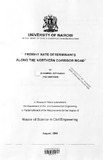| dc.description.abstract | This study is the first comprehensive and empirical effort to measure and quantify the determinants of freight rates and transport costs in Kenya. Accordingly, a model has yet to be developed which represents in detail the relation of freight rates against factors influencing transportation costs. Ordinarily, transport costs between a specific origin and destination has mostly been determined through guesswork, and is based on the expenses incurred by transporters in fuel, spare parts and maintenance labour charges. For instance, the establishment of freight rates between any origin and destination is largely dependent on direct inquiries from transportation companies. Hence its reliability cannot be ascertained. This situation is further worsened by the lengthy precess, involved, and rates obtained which do not accurately represent what majority of transportation companies would charge. As a result, the freight customers are often exploited and inappropriate policies adopted by the country's transport sector.
In a free market, perfect competition is assumed whereby prices depend on demand and supply. Besides competition in the market, other factors that influence freight rates include vehicle operating costs (VOCs) , travel time between the origin and destination, freight tonnage, absence or presence of return cargo and truck category used for the transport. This research seeks to establish the relationship between factors influencing freight rates along the transport corridor, using the Northern Corridor road in Kenya as a case study.
The Northern Corridor road network extends from the Kenyan seaport of Mombasa, on the Indian Ocean, and offers a passageway to the landlocked countries of Uganda, Rwanda, Southern Sudan, and Eastern Democratic Republic of Congo respectively. For the purposes of this thesis, a survey was conducted to establish the number of transporters and various categories of motor vehicles using the aforementioned transport corridor. Likewise, key informant interviews were carried out to determine the vehicle operating costs (VOCs) , and data analyzed using Statistical Package for Social Sciences (SPSS), and Excel. In addition, the use of Global Positioning System (GPS) equipment was employed in order to establish travel time data, which was later analyzed by Ozi explorer.
Based on the investigated parameters, two freight transport cost prediction models were developed to simulate the relationship between transport costs and VOCs, while taking into consideration other factors influencing the freight rates. The parameters adopted to develop the Freight Transport Cost Prediction Model (FTCPM) were an inexpensive means of data collection. The first model is a multiple linear regression equation which estimates the freight rate charged by transporters, The model can be used to estimate the freight transport rates (US$/ton-km) where input variables are known. The second model is an exponential equation which shows the sensitivity of freight rates to VOCs, which is applied in predicting freight rates. Findings revealed that transport rates increase alongside the vehicle operating costs within a specific range. Furthermore, the degree of influence of each factor varies depending on the truck category, that is, whether classified as a light/medium or heavy truck.
The transport rates vary substantially with vehicle operating costs, distance and tonnage in the case of heavy trucks. While for light/medium trucks, freight rates depend mostly on distance, tonnage and whether there is a return cargo or not. It was also established that heavy trucks had-hiqh vehicle operating costs, while light trucks had low vehicle operating costs. In both cases the tyre and fuel consumption was more than 50 percent of the operating costs. Conversely, findings revealed that light trucks had the highest freight transport rates per tonkm, while heavy trucks had the lowest freight rates per ton-km.
This research study recommends that sections of the Northern Corridor road which experienced a repeated change of horizontal alignment be realigned to shorten the distance covered, and lower vehicle operating cost. In addition, the maximum allowable cargo weight limit should be strictly enforced at weigh bridges to prevent high vehicle operating costs.
Key Words: Transport Cost, Freight Rates, Vehicle Operating Costs, Trucks, Regression. | en_US |

